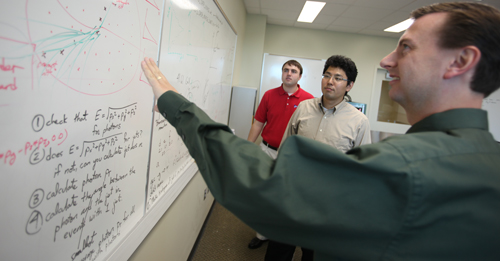Baylor physicists contribute to historic Higgs boson findings

In between the Independence Day parades and fireworks, you may have caught the news yesterday that an international team of scientists at CERN may have found the elusive Higgs boson particle, filling a gap in physics theory that has been pursued for decades. (Despite its technical nature, the news was CNN.com’s most popular story yesterday.)
What you may not have seen is Baylor’s connection to the findings. Since 2010, Baylor researchers in the university’s Experimental High Energy Physics group have been engaged in the experimental particle physics research being conducted at the European Center for Nuclear Research (CERN) in Geneva, Switzerland. (The Baylor group has also been involved with similar research at Fermilab, a U.S. Department of Energy laboratory in Illinois, since 2005.)
It was the scientists working at CERN who discovered this new particle that may be the Higgs boson. In short, the Higgs boson particle explains the origin of mass in elementary particles. (I know; I wasn’t a physics major, either. If you want more explanation, here’s an excellently accessible breakdown.)
The High Energy Physics group at Baylor is led by Dr. Jay Dittman and Dr. Kenichi Hatakeyama. At the same International Conference on High Energy Physics where CERN’s findings were announced yesterday, a member of the Baylor group, Dr. Azeddine Kasmi, presented the latest results of Higgs boson work being done at Fermilab. The U.S. center’s research has long influenced the work being done at CERN; Fermilab’s particle accelerator was completed in 1983, more than two decades before CERN’s came online.
“We’re thrilled to be a part of this extraordinary scientific endeavor,” says Dittmann, who still teaches at least one introductory physics course a year in addition to multiple upper-level courses. “Members of our Baylor team have been involved in the search for the Higgs boson at all levels, from analyzing data to presenting high-profile scientific seminars to composing publications for our scientific collaboration. Now, we can finally claim the observation of a new particle that could be the long-sought Higgs boson. It’s tremendous. Determining whether this new particle really is the Higgs boson predicted by theory is the next step.”
Sic ’em, Baylor physics researchers!

